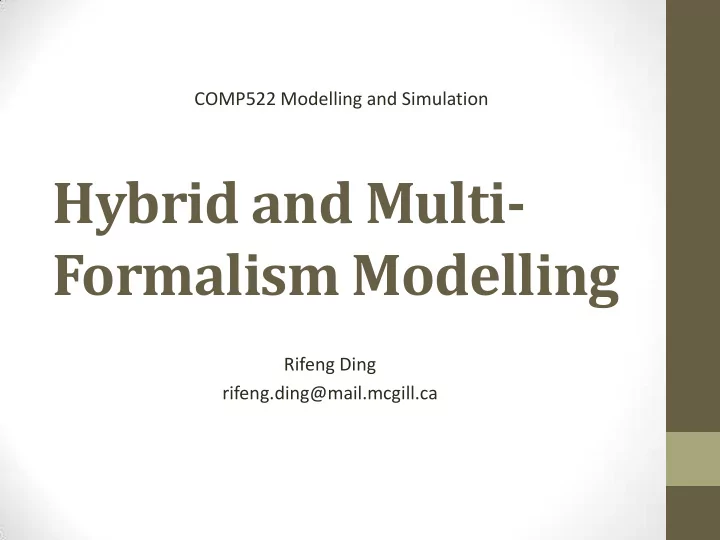

COMP522 Modelling and Simulation Hybrid and Multi- Formalism Modelling Rifeng Ding rifeng.ding@mail.mcgill.ca
Overview • Hybrid Modeling System • Purpose of the Project • Tool: HyVisual in Ptolemy II • Project: A Train System • Demo • Conclusion 2
Hybrid Modelling System [1] • Heterogeneous systems including continuous-time subsystems interaction with discrete events • Effective to model physical systems interacting with software or undergoing discrete mode changes [1] Edward A.Lee and Haiyang Zheng . “Operational Semantics of Hybrid Systems.” in Hybrid Systems: Computation and Control: 8 th 3 International Workshop, 2005, pp.25-53
Hybrid Modelling System • Continuous Subsystem • Using differential equations • Discrete Event • Using finite state machines • Transitions between states represent either discrete mode changes or actions taken by software subsystems 4
Purpose of this project • Explore how to use hybrid modelling formalism to stimulate real-world system: • Tools: HyVisual in Ptolemy II • Simulated system: A Train System • Show the advantages of hybrid modelling formalism 5
Tool: HyVisual in Ptolemy II • Ptolemy Project [2] • UC Berkeley EECS Department • Study modeling , simulation, and design of concurrent, real-time, embedded systems • http://ptolemy.eecs.berkeley.edu/index.htm • Ptolemy II • A open-source software framework supporting simulation experimentation with actor-oriented design 6 [2] UC Berkeley EECS Dept. “Ptolemy Project.” Internet: http://ptolemy.eecs.berkeley.edu/, Oct. 7, 2005 [Apr. 20. 2012]
Tool: HyVisual in Ptolemy II • HyVisual [3] • Hybrid System Visual Modeler • Block-diagram editor and simulator for continuous-time dynamical systems and hybrid systems • Supporting construction of hierarchical hybrid systems • Using block-diagram representation ordinary differential equations (ODEs) to define continuous dynamics • Using finite state machine to define discrete events • Allowing mix of continuous-time signals with events that are discrete in time 7 [3] UC Berkeley EECS Dept. “ HyVisual – Hybrid System Visual Modeler.” Internet: ptolemy.eecs.berkeley.edu/Hyvisual/index.htm, Oct. 7, 2005 [Apr. 20. 2012]
Tool: HyVisual in Ptolemy II • HyVisual: 8
HyVisual: Directors • Continuous Directors (Simulator) • Manage the continuous simulation • Contains a sophisticated ODE solver 9
HyVisual: Actors • Actors: software components that can execute concurrently and communicate through messages sent via inter connected ports 10
HyVisual: Actors • Actors used in this project: • Modal Model Actor • Source Actor: • const actor • Mathematical Actors: • Add/Abstract actor • Scale actor • Continuous Actors: • Integrator actor • Resettable timer actor • Random Actors: • uniform random Actor 11
HyVisual: State Machine • An example: bouncing ball 12
HyVisual: Hierarchical Models Continuous Actors State State Input/output ports Transactions Continuous Model (a Modal Model Actor) State Continuous Model 13
Project: Simulation of A Train System • Discrete Event: • loading and unloading passengers • Change between modes • Continuous dynamics: 14 • Train accelerating and decelerating
Project: Simulation of A Train System • Empty train (discrete ): • Load passengers, until the train is full • Full train (continuous & discrete): • Leave the station, start accelerating • Velocity control: bang-bang control • Get close to the destination, start baking until stop at the destination's station • Arrive at the destination (discrete): • Unload passengers 15
More Details & Demo 16
Conclusion • Build a hybrid system: the Train System using HyVisual • Based on block-diagram – straightforward, easily handle complicated hierarchical structures • Hybrid Modelling : • Embrace discontinuities and discrete events along with the usual piecewise continuous signals • Provide modelling semantics and results that are not only predictable, but easily understandable 17
Hybrid and Multi-Formalism Modelling Question? 18
Recommend
More recommend